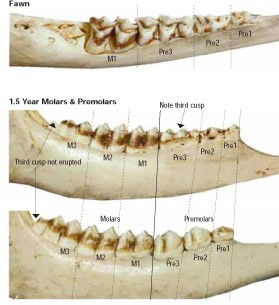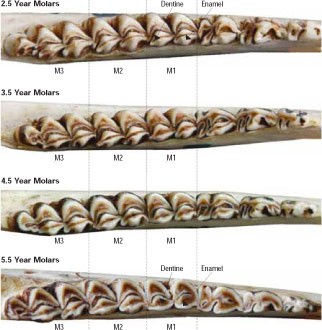Estimating the age of a deer by studying the tooth wear and eruption patterns on the lower jawbone is not an exact science, but it’s free, you can perform the task yourself, and nearly anyone can learn the basic criteria for distinguishing each age class.
By assessing tooth eruption patterns, which is to say, the way in which a deer’s teeth have emerged from the jaw, hunters can definitively separate deer into three age classes: fawns, yearlings, and those two years old and older. Next, by studying wear patterns, they can often do a respectable job at telling the two-, three-, four-, and five-year-olds apart. Don’t bet your house or even your favorite hunting hat on your aging precision for deer older than two, but the technique is fine for general purposes.
Here are the basics on how it’s done. First you need to remove the lower jaw with a knife and/or lopping shears. Clean the meat from the jaw and hold it in your hand so that you’re looking at the cheek side. Don’t pay attention to the teeth (incisors) in the very front. You’re only interested in the teeth at the back of the jaw.
Fawn
Adult deer have six teeth in the rear of the lower jaw – three premolars and three molars. If the jaw you’re looking at has fewer than six teeth, it’s from a fawn. The fawn jaw pictured here has four teeth – three premolars and one molar. The second molar is just starting to erupt.
Yearling
Yearling deer already have all six teeth – three premolars and three molars. The third premolar may have three cusps as seen in the first yearling photo or two cusps as seen in the second yearling photo. If the jaw has six teeth and the third premolar has three cusps, it’s from a yearling. If the jaw has six teeth and the third premolar has two cusps, it may or may not be a yearling; you need to check another characteristic. Look at the last cusp of the third molar (last tooth in the jaw). If this cusp is not fully erupted, it is from a yearling. Notice in the first yearling photo that this cusp is not through the gumline (the bright white portion of the teeth below the brown staining would have been below the gumline), and in the second yearling photo, the cusp just barely broke through but is not fully erupted like the rest of the tooth.
2.5 Years and Older
In older deer, the third premolar has two cusps, and all cusps of the third molar are fully erupted. Astute observers can attempt to separate this group into individual age classes by studying wear patterns on the teeth. As deer age, their teeth wear down, and more dentine (the brown you see on the tooth) is exposed. As a general rule, young deer have little dentine exposed, middle-aged deer have a moderate amount, and older deer have a lot of dentine exposed.
Separating older deer into specific age classes requires comparing the width of dentine to the width of enamel on either side of it on the three molars. On a two year-old deer, the width of dentine on the first molar will be less than twice as wide as a width of enamel around it. On a three year-old, the width of dentine will be at least twice as wide as a width of enamel around it on the first molar, and less than twice as wide as a width of enamel around it on the second and third molars. On a four-year-old, the width of dentine will be at least twice as wide as the width of enamel around it on the first and second molars and less than twice as wide as a width of enamel around it on the third molar. Once a deer gets above five years old, the width of dentine will be at least twice as wide as the width of enamel on all three molars.
Remember, sorting deer that are older than two and one-half years is subjective, and can depend on the experience of the person doing the sorting. The condition of the jaw may be influenced by the deer’s diet and geographic location. I have aged hundreds of jawbones in my work as a wildlife biologist, and I’m amazed at how many “tweeners” look suspiciously like older deer. The only way to know for sure how old a deer is – and even then we’re not talking 100 percent – is to send an incisor from the lower jaw to a commercial lab and have it aged by cementum annuli analysis, a process by which a cross section of the tooth’s root is stained and studied under magnification.
Estimating age from jawbones is fun and useful, and I strongly encourage all successful hunters to try it for themselves. The next time you shoot a deer, along with the venison and memory, be sure to collect a jawbone.



